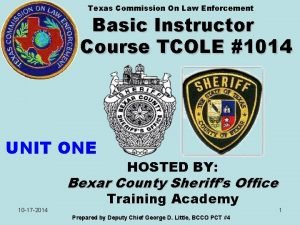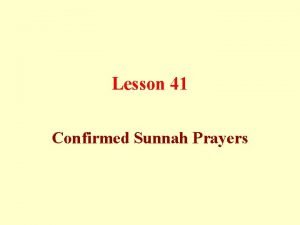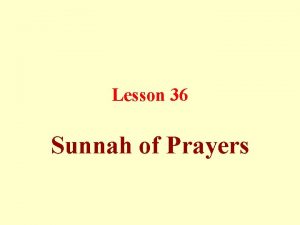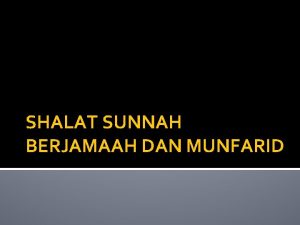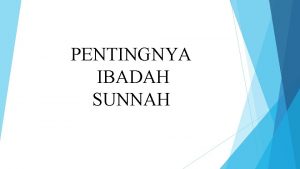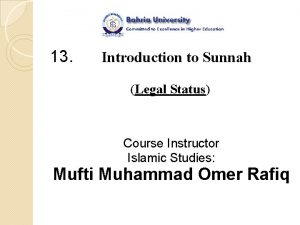11 Introduction to Sunnah Sunnah Course Instructor Islamic













- Slides: 13

11. Introduction to Sunnah (Sunnah) Course Instructor Islamic Studies: Mufti Muhammad Omer Rafiq

HADITH & SUNNAH: DEFINATION: Hadith is the second source of Islamic law and in Islamic terminology every deed, saying and sermon delivered or any act done in the presence or knowledge of Holy Prophet (SAW) and to which he did not express his dislike is called Hadith.

Abu Bakr al-Jassas (370 H. ) stated in al-Fusool fil Usool a clearer definition, when he said: "The Sunnah of the Prophet "( ( ﺻﻠﻰ ﺍﻟﻠﻪ ﻋﻠﻴﻪ ﻭ ﺳﻠﻢ is what he said or did in continous manner so that others follow"[، ﺍ : ﺍﻟ ﻯ ﺍﻟ . [ ﺍ ، ﻯ ﻳ

Followings are the types of Sunnah • Sunnat-ul-Qual: all words, counsels or precepts of the Holy Prophet (PBUH) • Sunnat-ul-Fieel: his action, works and daily practices • Sunnat-ul-Taqrir: his silence implying a tacit approbation on his part of any individual act committed by his disciples

• b) ‘ilmul Hadith dirayatan is that branch which discusses the rules of narrating a Hadith, the grading of the Hadith, the reliability of the narrators and the deduction of legislation ( ( ﺃﺤﻜﺎﻡ there from etc. • a) ‘ilmul Hadith riwayatan is that branch which consists of the mere reciting of the Hadith with absolute precision.

• RIWAYAT 1. 2. 3. Discuss with sanad. Reporter of Hadith. Discuss with screening of reporter as his education, piety, power of memory, self control, patience, internal & external relation with others. • DERAYAT 1. 2. Verification of material. 3. If one hadith showing huge reward like jannat on a ordinary action or huge punishment like hell on a ordinary sin, hadith is weak a/c to the law of dirayat. 4. Any tribe reference property. 5. Prophecy projected words not excepted. Verification of Arabic grammar.


Imam Muslim documented in his Saheeh that Aisha ( ﺭﺿﻲ ﺍﻟﻠﻪ ( ﻋﻨﻬﺎ said: Going down "al-Abtah" is not Sunnah. The Prophet only went down there because it was easier for him when he wanted to exit the place" [ Saheeh Muslim: 1311] Imam al-Nawawi said in his Sharh: " Aisha and Ibn Abbas did not act upon it because thet viewed this act to happen not for a religious purpose. Yet, other companions acted upon it and because identifying whether this act was performed on religious basis or not, companions differed on it" From the above, we conclude that companions and scholars differentiated between the acts of the Prophet (. ( ﺻﻠﻰ ﺍﻟﻠﻪ ﻋﻠﻴﻪ ﻭﺳﻠﻢ They viewed acts that are performed on religious basis to get one closer to Allah as Sunnah while other acts that are done for other reasons as general acts.

• IMPORTANCE OF HADITH: 1)Practicable as Quran. 2)Does not say by his own will. 3)Explain what so ever revealed. 4)Who so obey Prophet. 5)If you want to love Allah.


• COMPILATION OF HADITH: 1) During the period of Holy Prophet , Hazrat Abdullah-ebne. Amar, Abu Huraira 5374, Ali and Anas were writing Ahadith of Holy prophet(saw). 2) In 99 Hijrah Hazrat Umer bin Abdulaziz gave order to Hazrat imam Zohri. 3) Imam abu Hanifa (Kitabul asar), Imam Malik(muatta), Sufyan sorri (kitabul jamay). 4) Saheh Bukhari by imam Bukhari, Saheh Muslim by Imam Muslim, Sunan Tirmazi by Imam Tirmazi, sunan Abu dawood by Imam dawood, Sunan Nissae by Imam Nisaae and Sunan Ibne Maja by Imam Maja. (Sahahey Sittah)

• 1. Muhammad b. Ismail al Bukhari, (194 A. H. -256 A. H. ): Sahih. This work is next to the Quran in authenticity. 2. Muslim bin Qushairi (204 A. H. -261 A. H. ): Sahih. This is the next most important work on Hadith. 3. Ibn Majah (202 A. H. -275 A. H. ): Sunan 4. Abu Isa al Tirmizi (209 A. H. -279 A. H. ): Jame 5. Abu Abdur Rahman an Nasai (214 A. H. -303 A. H. ): Sunan 6. Abu Da‘ud (202 A. H. -275 A. H. ): Sunan

• 1. The first stage relates to the period of the Prophet till 10 A. H. 2. The second stage is approximately from 11 A. H. to 100 A. H. This is the period of Sahaba, the companions of the Prophet. 3. The third stage is from about 101 to nearly 200 A. H. This is the period of the Tabiun, the disciples of the companions of the Prophet. 4. The fourth stage is roughly from 200 A. H. to 300 A. H. This is the period of Taba Tabiun, the disciples of the disciples.
 Tcole instructor course
Tcole instructor course Basic instructor course texas
Basic instructor course texas Basic instructor course #1014
Basic instructor course #1014 Pepperball training manual
Pepperball training manual Tcole advanced instructor course
Tcole advanced instructor course Basic instructor course #1014
Basic instructor course #1014 Tcole 1014 basic instructor course
Tcole 1014 basic instructor course Usmc jrotc vacancies
Usmc jrotc vacancies Tcole advanced instructor course
Tcole advanced instructor course Tcole advanced instructor course
Tcole advanced instructor course Jrotc marksmanship instructor course online
Jrotc marksmanship instructor course online Basic instructor course #1014
Basic instructor course #1014 Basic instructor course #1014
Basic instructor course #1014 How to install a lintel in a single brick wall
How to install a lintel in a single brick wall











